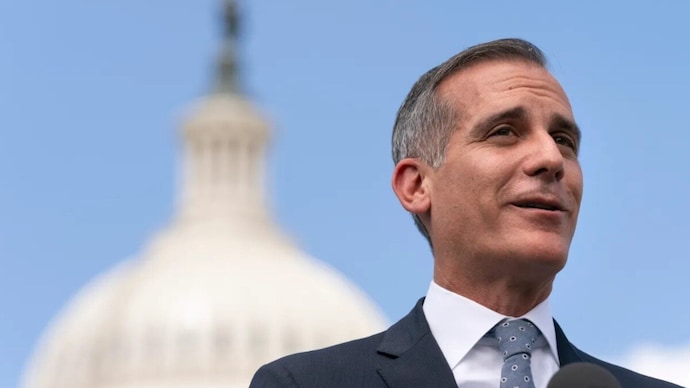US Dismisses Report Linking India-US Relations to India-Canada Row

US Dismisses Report Linking India-US Relations to India-Canada Row
In recent days, an intriguing report surfaced suggesting a potential strain in the robust relationship between the United States and India, ostensibly attributed to the ongoing India-Canada diplomatic tensions. The report claimed that Eric Garcetti, the US Ambassador to India, had purportedly conveyed to his team that bilateral ties between the two nations “could get worse for a time.” However, in a swift response, the US Embassy in India has emphatically rejected this assertion, emphasizing Ambassador Garcetti’s unwavering commitment to strengthening the partnership between the United States and India.
The report had stirred considerable interest and speculation, prompting a swift and assertive response from the US Embassy in India. Ambassador Garcetti, who took office in December 2021, has been ardently dedicated to advancing diplomatic relations between the two nations, according to the Embassy’s statement. His tenure has seen a flurry of diplomatic activities aimed at bolstering cooperation, trade, and people-to-people ties.
While the report suggested a potential strain due to the India-Canada row, it’s important to understand the broader context of India-US relations and the multitude of factors that contribute to the dynamic between these two influential nations.

The backdrop of India-US Relations:
The United States and India share a multifaceted relationship that has evolved significantly in recent years. Bilateral ties have deepened across various sectors, including defense, trade, technology, and culture. This partnership is often referred to as the “defining partnership of the 21st century,” owing to its far-reaching implications on global politics and economics.
Strategic Partnerships:
One of the cornerstones of India-US relations is their strategic alignment. Both nations recognize the importance of maintaining peace and stability in the Indo-Pacific region. In recent years, they have engaged in joint military exercises and dialogues aimed at bolstering regional security.
Economic Collaboration:
Economic collaboration has been a pivotal driver of India-US relations. The two nations have witnessed a surge in trade and investment, with the United States being one of India’s top trading partners. Furthermore, they have cooperated in areas such as clean energy, healthcare, and technology.
People-to-People Ties:
People-to-people ties between India and the United States are flourishing. The Indian diaspora in the US plays a significant role in fostering cultural exchange and contributing to both nations’ economies. Additionally, educational exchanges and research collaborations continue to strengthen these bonds.
The India-Canada Row:
The reported link between the India-Canada diplomatic row and potential tensions in India-US relations merits closer examination. The diplomatic standoff between India and Canada primarily revolved around Canada’s concerns regarding human rights in India, particularly in the context of protests and political developments. While such issues can have reverberations in international diplomacy, it is essential to note that diplomatic relations are shaped by a multitude of factors and are rarely reduced to a single incident or disagreement.
Ambassador Garcetti’s Stance:
The US Embassy’s robust dismissal of the report attributing strain in India-US relations to the India-Canada row underscores Ambassador Garcetti’s dedication to fostering a strong and enduring partnership. Ambassadors are tasked with representing their country’s interests while also facilitating dialogue and cooperation with the host nation. In this role, Ambassador Garcetti has demonstrated his commitment to advancing US-India relations on multiple fronts.
The resilience of India-US relations rests on a solid foundation of shared democratic values, economic interdependence, and converging strategic interests. Both nations recognize the importance of maintaining a free, open, and inclusive Indo-Pacific region, which has become a focal point for discussions on regional stability and security. The Quad, a grouping that includes the United States, India, Japan, and Australia, has gained prominence as a platform for addressing regional challenges, including those posed by an assertive China.
Furthermore, the global response to pressing issues like climate change and the COVID-19 pandemic has further underscored the need for collaboration between India and the United States. The US-India Climate and Clean Energy Agenda, for instance, highlights their commitment to tackling climate change and promoting sustainable development. The partnership’s resilience extends to healthcare, with cooperation in vaccine development, distribution, and strengthening healthcare systems.
Despite the occasional bumps in the road, India-US relations continue to thrive due to their dynamic nature and a shared vision of a peaceful, prosperous world. Both nations recognize that addressing global challenges requires a cooperative approach, and their partnership remains essential in shaping the international landscape.

Conclusion:
In the complex arena of international diplomacy, reports and rumors can sometimes overshadow the broader context of diplomatic relations. While the report linking India-US relations to the India-Canada row gained attention, it is essential to approach such claims with a discerning eye and consider the broader trajectory of the relationship. The United States and India share a robust partnership that encompasses strategic alignment, economic collaboration, and people-to-people ties. Ambassador Garcetti’s proactive efforts in enhancing these ties underline the enduring nature of this critical bilateral relationship.
As both nations continue to navigate the intricacies of global politics and economics, the strength of India-US relations remains pivotal in shaping the course of the 21st century. While challenges and disagreements may arise from time to time, the commitment to shared values and interests serves as a foundation for continued cooperation and collaboration.




